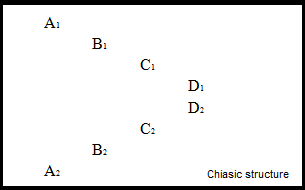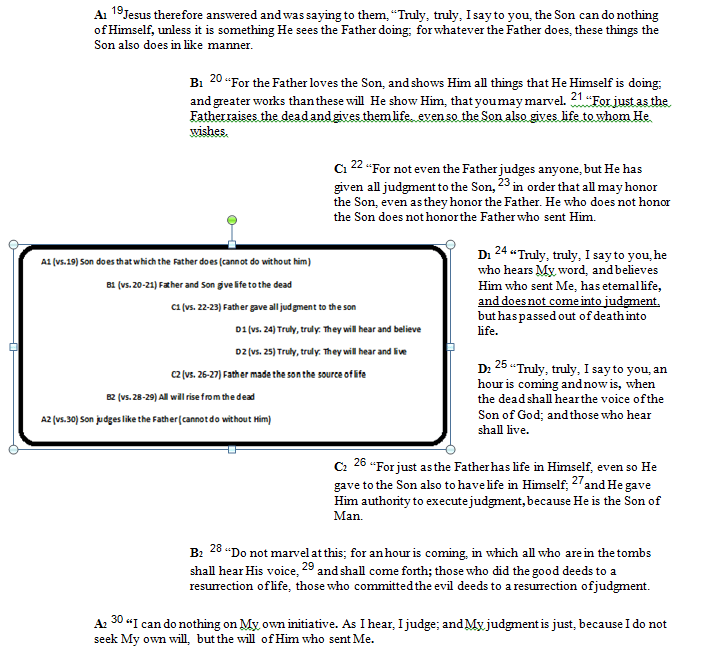Today we come to a very interesting text in John 5.19-30. If you have been reading this commentary carefully you may be surprised to find that I took such a long text for consideration all at once instead of dividing it up on many smaller pieces as I usually do. That is so, because here we meet an obvious and unquestionable example of an ancient form of literary design – chiasm and one of the many functions of chiasm is to help the interpreter to clearly see where the literary unit begins and where it is brought to a literary conclusion. It is easier to first show a diagram how chiastic structure looks like and then to attempt to explain it. The literary unit when analyzed has the following structure:
 The sentence either word by word or at the very list in thought by thought is repeated in the beginning and in the end of the literary unit. It is as if the original author goes from A1 to B1, from B1 to C1, from C1 to D1. But then all of the sudden the original writer of the text switches gears and moves backwards in the exactly the same order (D2, C2, B2, A2).
The sentence either word by word or at the very list in thought by thought is repeated in the beginning and in the end of the literary unit. It is as if the original author goes from A1 to B1, from B1 to C1, from C1 to D1. But then all of the sudden the original writer of the text switches gears and moves backwards in the exactly the same order (D2, C2, B2, A2).
If you have never heard of such a thing called chaism do not be alarmed, most people living in the modern times and reading modern literature have not. Yet a simple google search will uncover a huge literary and interpretive field that makes use of interpreting the Bible with the help of finding all kinds chiastic structures throughout the Bible seemingly omnipresent.
Before we even begin to wet our feet in the Chaistic interpretive ocean, please, allow me the privilege of a disclaimer. When it comes to finding chiasms in all imaginable places in the Bible I am a skeptic. I come kicking and screaming before I acknowledge that when looking at a given text we are indeed finding ourselves in the presence of chiasm. For example, many scholars have sought to show that the entire Gospel of John (not to mention other books) follow this kind of ancient literary bit, rhythm and structure – we today call chaism. Up until now, however, within my study of John I have not yet been persuaded that the Gospel of John is indeed structured as such, when it comes to its entire 21 chapters. I feel that often times interpreters tend to fit the biblical facts into their own theories and not vice versa as it should be.
However, after this lengthy disclaimer, by a chiastic skeptic like myself I must admit that I am finally persuaded that John 5.19-30 is indeed structured as a clear cut chiasm. Not only are thought-by-thought parallel repetitive structures are present, but my positive identification of it as a true (and not apparent) chiasm is safeguarded by word-by-word clear repetitive occurrences as well.
This week I would like you to get a basic grasp on what chaism means, next week I will show you how to interpret it responsibly. So make sure you come back in a week to see the update to this study. And, yes, you should be proactive and look up the word “chaism” or “chiastic structure” on the web. So here it is, can you see my point?
To receive more information about learning Biblical Languages with Hebrew University of Jerusalem/eTeacher Biblical program online at affordable cost, please, click here.
© By Eli Lizorkin-Eyzenberg, Ph.D.
To sign up for weekly posts by Dr. Eli, please, click here. It is recommend by Dr. Eli that you read everything from the begining in his study of John. You can do so by clicking here – “Samaritan-Jewish Commentary”.










So much rich food for thought.
Thank you, as always.
Jane M.
You are most welcome, Jane.
Just a note of an incorrect spelling in your first paragraph “chaism” when it should be “chiasm.”
That is so, because here we meet an obvious and unquestionable example of an ancient form of literary design – chaism and one of the many functions of chiasm is to help the interpreter to clearly see where the literary unit begins and where it is brought to a literary conclusion.
Thanks, fixed it.
Thanks Dr. Eli. I just read the article and found it very interesting. It really makes sense. What about the other big themes that the 4th Gospel and the 3 “John” letters address, which are Love, Death and Life? Could it be that this author not only was very close to the Temple as , but also that he experienced love, death and life himself? In other comment, I was wondering why Lazarus’ experience with life after death experience was not recorded. Maybe it was. This 4th Gospel and the 3 letters could have been written by Lazarus, being himself the young rich in Mark 10:21 and also the beloved disciple. This beloved disciple was indeed a disciple of John the Baptist. He not only recorded what John said about Jesus increasing while John decreasing. (John 3:30) but also had to practically “disappear” and become an anonymous witness because of the fame that was around him after being raised from the dead. (John 12:9-11) This disciple records (John 20:7) in a very detailed way the napkin (sudarium) that was left in Jesus empty tomb… he just happened to have one on himself just a few days earlier! (John 11:44) No wonder he didn’t get into Jesus tomb at once even though he got there before Peter… Can you imagine going back to such place after being there for 4 days? Just wondering.
All Gospels are originally written with reference to their authors. So are psalms for that matter and many other books in the Bible. Can this be Lazarus? yes of course. John 11 may fit perfectly into this hypothesis as well as things that you bring up. Jesus weeping bitterly at his passing also points towards that (beloved disciple).
Thanks for this insight of such a Hebrew form of writing. Do you think that a fisherman of the 1st century could write this way? Don’t you think that this way of writing would come from a more educated 1st century Jewish man? Doesn’t the Gospel of John sound as if a theologian or a well educated man wrote it? When you think “outside the box” and you read this Gospel, you might find that who wrote it could well be someone who is not one of the “twelve”. Someone who is a witness of many things that Jesus did but is not a witness of all the things that Jesus did with the “twelve”. This writer “knows” first hand about life and death. He writes about it through all the Gospel. He also writes about being loved because he knows about being loved by Jesus with a Heavenly Love. Just as the young rich was loved by Jesus. (Mark 10:21) Just as Lazarus was loved by Jesus. (John 11:3) Everyone knew that Jesus loved this young man named Lazarus (John 11:36) Could a Galilean fisherman be known at the house of the HIgh Priest? (John 18:15-16) Maybe a wealthy young disciple is a better choice of knowing the High Priest and also knowing Nicodemus well enough as being able to have written in a very detailed fashion the account of Jesus and Nicodemus night encounter? (John 3)
Alfredo, I agree. Read an article by Mark Kinzer on the Gospel of John and Temple in the “featured articles” section. He argues that the author was Jerusalem-based priest. Dr. Eli